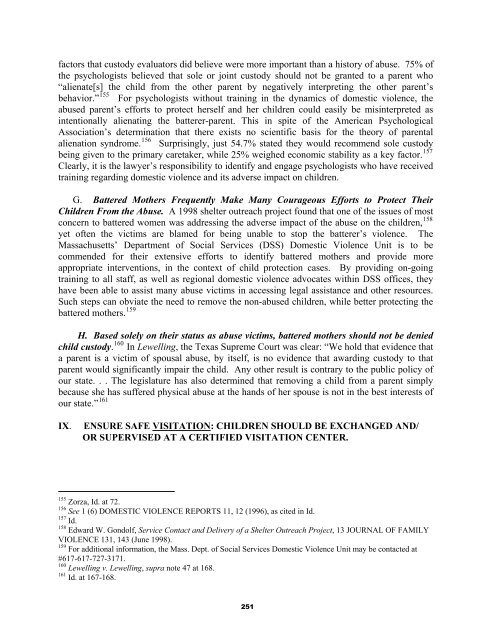A Judge’s Guide
A Judge’s Guide
A Judge’s Guide
Create successful ePaper yourself
Turn your PDF publications into a flip-book with our unique Google optimized e-Paper software.
factors that custody evaluators did believe were more important than a history of abuse. 75% of<br />
the psychologists believed that sole or joint custody should not be granted to a parent who<br />
“alienate[s] the child from the other parent by negatively interpreting the other parent’s<br />
behavior.” 155 For psychologists without training in the dynamics of domestic violence, the<br />
abused parent’s efforts to protect herself and her children could easily be misinterpreted as<br />
intentionally alienating the batterer-parent. This in spite of the American Psychological<br />
Association’s determination that there exists no scientific basis for the theory of parental<br />
alienation syndrome. 156 Surprisingly, just 54.7% stated they would recommend sole custody<br />
being given to the primary caretaker, while 25% weighed economic stability as a key factor. 157<br />
Clearly, it is the lawyer’s responsibility to identify and engage psychologists who have received<br />
training regarding domestic violence and its adverse impact on children.<br />
G. Battered Mothers Frequently Make Many Courageous Efforts to Protect Their<br />
Children From the Abuse. A 1998 shelter outreach project found that one of the issues of most<br />
concern to battered women was addressing the adverse impact of the abuse on the children, 158<br />
yet often the victims are blamed for being unable to stop the batterer’s violence. The<br />
Massachusetts’ Department of Social Services (DSS) Domestic Violence Unit is to be<br />
commended for their extensive efforts to identify battered mothers and provide more<br />
appropriate interventions, in the context of child protection cases. By providing on-going<br />
training to all staff, as well as regional domestic violence advocates within DSS offices, they<br />
have been able to assist many abuse victims in accessing legal assistance and other resources.<br />
Such steps can obviate the need to remove the non-abused children, while better protecting the<br />
battered mothers. 159<br />
H. Based solely on their status as abuse victims, battered mothers should not be denied<br />
child custody. 160 In Lewelling, the Texas Supreme Court was clear: “We hold that evidence that<br />
a parent is a victim of spousal abuse, by itself, is no evidence that awarding custody to that<br />
parent would significantly impair the child. Any other result is contrary to the public policy of<br />
our state. . . The legislature has also determined that removing a child from a parent simply<br />
because she has suffered physical abuse at the hands of her spouse is not in the best interests of<br />
our state.” 161<br />
IX. ENSURE SAFE VISITATION: CHILDREN SHOULD BE EXCHANGED AND/<br />
OR SUPERVISED AT A CERTIFIED VISITATION CENTER.<br />
155 Zorza, Id. at 72.<br />
156 See 1 (6) DOMESTIC VIOLENCE REPORTS 11, 12 (1996), as cited in Id.<br />
157 Id.<br />
158 Edward W. Gondolf, Service Contact and Delivery of a Shelter Outreach Project, 13 JOURNAL OF FAMILY<br />
VIOLENCE 131, 143 (June 1998).<br />
159 For additional information, the Mass. Dept. of Social Services Domestic Violence Unit may be contacted at<br />
#617-617-727-3171.<br />
160 Lewelling v. Lewelling, supra note 47 at 168.<br />
161 Id. at 167-168.<br />
251


